Extract from The Guardian
Report commissioned by Wave Swell Energy says the machines would make a future clean electricity grid more stable and more reliable.

Wed 5 Oct 2022 03.30 AEDT
Last modified on Wed 5 Oct 2022 03.31 AEDTThe report was commissioned by Wave Swell Energy, an Australian company that has just finished a 12-month trial of its pilot plant on a beach at King Island, north of Tasmania.
But the company’s chief executive said while there was an impending boom in demand for wave energy plants, his company was looking to Europe and the United States for contracts where policies and markets were more supportive.
Wave Swell’s small 200MW demonstration unit near Grassy started exporting electricity into the island’s micro-grid in June last year, and is about to be decommissioned after the end of the trial.
The “UniWave 200” works like a blowhole, where air pressure in a tube caused by the rising and falling of water turns a turbine. All moving parts are above the water and the turbine only turns as the water level drops.
He said the consistency of waves coming in to shore meant power from the unit was available for long periods.
“It’s a great compliment to wind and and solar,” he said. “It adds to the supply of electricity before you start to need to consider storage.”
The Australian Renewable Energy Agency gave the company $4m to help design, build and deploy the $12m demonstration plant at King Island, off Tasmania.
“We’ve come off the pilot project feeling really good about the technology,” Geason said.
The site was not picked for the most energy intensive waves, but for accessibility and the variety of wave action.
The CSIRO report modelled the affect of deploying 1MW-sized wave plants like the unit at King Island at three locations: Cape Nelson and Warrnambool, both in western Victoria, and Carpenter Rocks in South Australia.
Dr Peter Osman, an engineer and honorary fellow at CSIRO and a co-author of the report, said adding wave energy to grids with lots of solar and wind made the system more reliable and stable.
But he said, as electricity grids pushed out fossil fuels, adding wave energy drastically reduced the amount of money needed to be spent on batteries “by a factor of four or five”.
“As you approach 80% or 90% renewable energy you will be thinking more and more about how to make your energy reliable,” he said. “That’s when people will be thinking about the costs of battery storage. That’s when wave energy will really come into its own.”
Previous CSIRO research commissioned by Wave Swell suggested a levelised cost of electricity from the company’s technology could reach 5c per kilowatt hour – comparable to the cheapest onshore wind or solar.
The International Energy Agency’s scenario for reaching net zero emissions by 2050 has ocean power generation climbing by more than 15 times current levels by 2030.
Geason said the company’s next move was to secure orders for larger 750kW and 1MW units.
The demonstration unit was built in Tasmania, but the company is eyeing markets in Europe and the US.
Stephanie Thornton, manager of the industry-led Australian Ocean Energy Group, of which Wave Swell is a member, said wave energy was less mature than other renewables but the technology for wave and tidal power was diverse.
“In Australia there has not been the kind of government support around technology advancement that there has been in other countries,” she said.
No comments:
Post a Comment